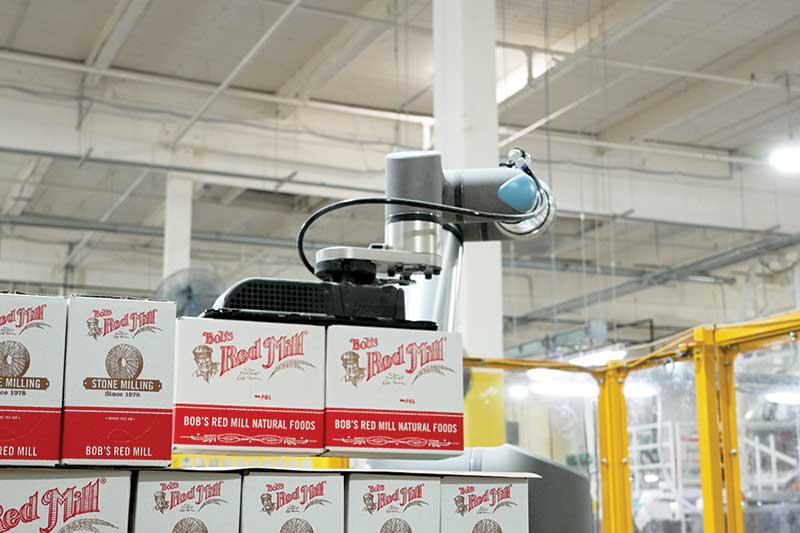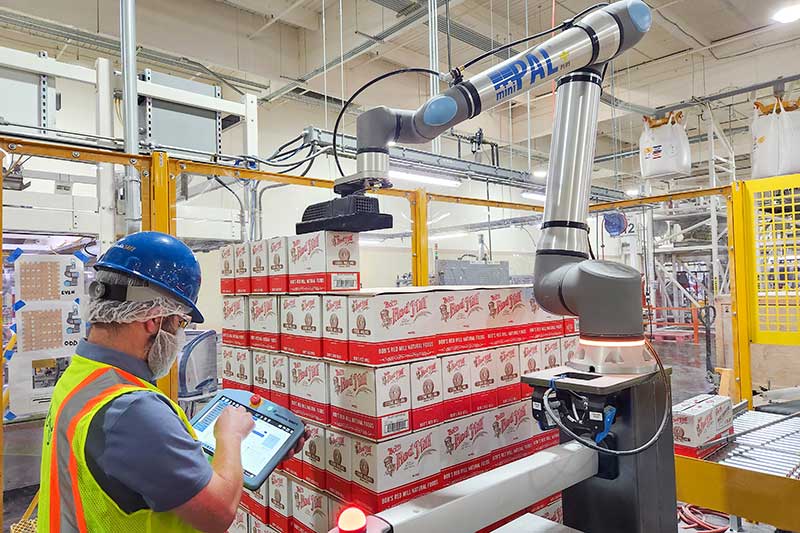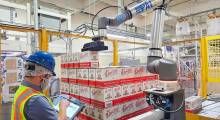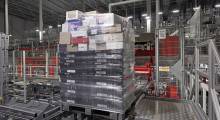The taste and joy of eating wholesome grains has made Bob’s Red Mill an internationally known manufacturer of food products including flours, cereals and mixes.
The Oregon-based company has grown from humble beginnings in 1978, when Bob Moore and his wife Charlee first started milling whole grain flours and cereals in an approximately 800,000-square-foot facility in Milwaukie, Ore. Now employing 700+ workers, the facility makes more than 200 different products distributed across the globe.
As Nick Chow, engineering and fabrication manager for the company, says, Bob’s Red Mill uses quartz millstones that grind whole grains at slow speeds and cool temperatures, a process that preserves nutrients and ensures fresh taste. While the milling process is based on historic tradition, the company’s packaging and product handling takes a high-tech approach, making use of robotic palletizing, first with industrial robots, and now with a solution based on a compact collaborative robot, or cobot, arm (Universal Robots) that can heft a 20-kg (44.1 pound) payload.
“Our vision is to double the number of people eating Bob’s Red Mill by 2030,” says Chow. “Automation will help us reach that goal.”
The operation started deploying larger industrial palletizing robots as the manual labor market dwindled during Covid. However, a solution that worked for the big production lines did not fit into smaller lines.
“We wanted a robot that could operate much closer to operators in more confined spaces,” Chow explains. “Collaborative robots fit that window between traditional industrial robots and hand palletizing, allowing us to be in a small footprint while still enabling our employee owners to safely interact with the palletizing system.”
The company began looking for a cobot that could meet the reach, payload and speed requirements of their plans, but didn’t find anything suitable until Chow stopped by Columbia/Okura’s booth at Pack Expo in fall of 2022. Columbia/Okura, a partner of Universal Robots (UR), had previously worked with Bob’s Red Mill in deploying larger robots.
“They told me they were working on something secretive and wanted to partner with Bob’s Red Mill,” says Chow. As it turned out, the secret was the soon-to-be-released UR20 cobot that Columbia/Okura was incorporating into their turnkey palletizer, the miniPAL+.
Chow was already somewhat familiar with UR’s cobots. “We appreciate the simplicity, their track record and the out-of-the-box features,” he says, recalling his excitement when he learned a UR cobot meeting his cycle time and payload was waiting in the wings. “We tried another cobot that was too sluggish to keep up with our production rate, so we kept hoping that UR would develop a bigger, faster cobot like this.”
The miniPAL+ is a turnkey palletizing system that includes the UR20 cobot arm, safety area scanners, radar, guarding, built-in pallet jack pockets, a vacuum gripper from PIAB, as well as PALLY, which is palletizing software from Rocketfarm, certified by UR for use with its cobots.
When the miniPAL+ hit the production floor at Bob’s Red Mill, it took a couple of hours to unbox and bolt everything together. “Our current production requires seven to eight cases per minute, but we are aiming for a 10- to 12-case rate, so with 14-case-per-minute capacity, we can also account for the time it takes to add slip sheets in between each layer and allow the cobot to catch up if needed,” Chow says, adding how the UR20’s 44.1 pound payload enables the company to double-pick boxes weighing between 4 to 10 pounds.

The miniPAL+ is caged on three sides with a small opening for the infeed conveyor on the back. The wide-open front allows interaction with the cell; when a worker or a forklift enters the cobot’s work envelope, the motion is detected by an area scanner and slows the cobot to a safe speed. In case of collision with the UR20, the cobot’s built-in force and power sensors immediately stop the cobot, preventing injury.
All programming happens though the PALLY software, directly on the cobot’s touchscreen. “It took roughly 45 to 60 minutes to get us all trained through a multitude of scenarios,” says Chow, who expects to do hundreds of product change-overs with the system.
A key benefit of the automated palletizing is that it frees up operators from repetitive manual tasks. “The employee owners here at Bob’s were really excited to see this palletizing technology come to their production line,” says Chow. “If you are producing well, we all get a share of the company profits. Automation is key in helping us grow and share our profits through profit sharing, while also reducing injuries so everybody goes home safely.”
The solution has freed up four operators over four shifts in the company’s 24-hour-operation. “Instead of stacking pallets all day long, the operators can now focus on more value-added tasks, such as quality inspection, instead of something boring,” says Chow, with a smile
Article topics








